
See also: the early WWI Long Lee-Enfield adapted for Royal Flying Corps aerial use.
and the WWII Spotlight Projector Anti-aircraft training attachment for use with
the S.M.L.E. Rifle, the Lewis Machine Gun, and the Thompson sub-machine gun.
Held in the National Firearms Collection at the Leeds Royal Armouries
and originally part of the Enfield Pattern Room Collection
This unusual adaptation of a No.1 Mk.III rifle has been experimentally fitted with a set of folding sights
specifically intended for anti-aircraft use.

The butt-disk is unmarked.
Built up by the Birmingham Small Arms Company on a 1916 " SHT LE " (Short Lee-Enfield) Rifle,
it was trialled during Spring that year.

The front sighting element is shown, above, raised (but without the windage arm extended), and folded flat, below.

The rear-sight was pivotted on the original rear volley aperture sight's fitting beneath the safety-catch "dumbell",
but the front volley sight dial and arm was never fitted.

The large rear aperture also folds neatly down against the stock above the magazine.

The rifle, viewed from the right-hand-side, with both sights raised.

Left below: the front sight raised with the windage arm yet to be deployed.
Centre: windage, or 'lead' arm extended, viewed from the rear.
Right: viewed from the muzzle.
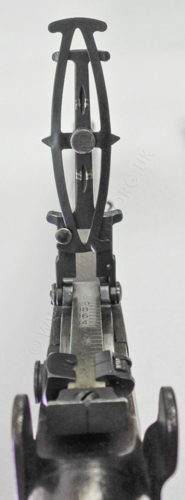 .........
.........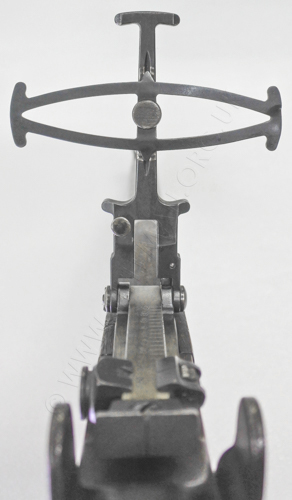 .........
.........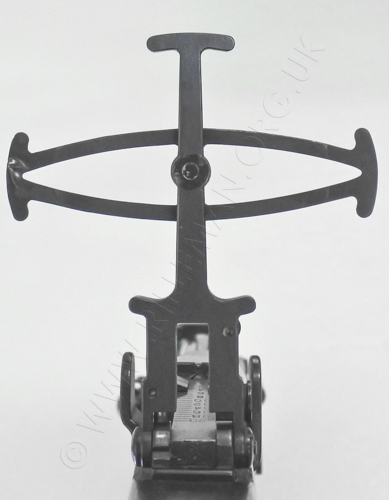
The sight picture.
The design was configured for an approximate range of 1,000 yards,
and for an aircraft travelling in the region of 110 knots.
This would require full width use of the windage or "Lead" arm
if the target was moving directly across the line of fire,
with an appropriate adjustment for other angles of approach or departure.
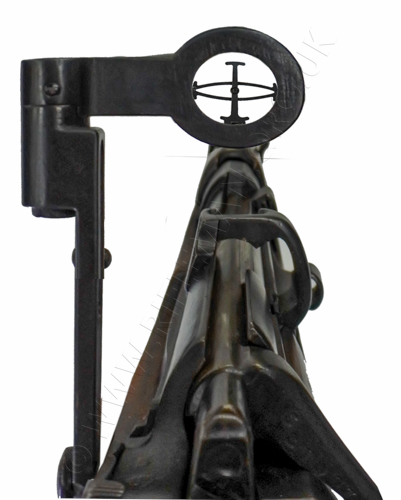
The butt-socket marking, with King George V's cipher.
The rifle's action, initially stamped up as a Mk. III *, has had the "*" barred out,
effectively returning it to just a Mk.III. The cut-off has been retained.
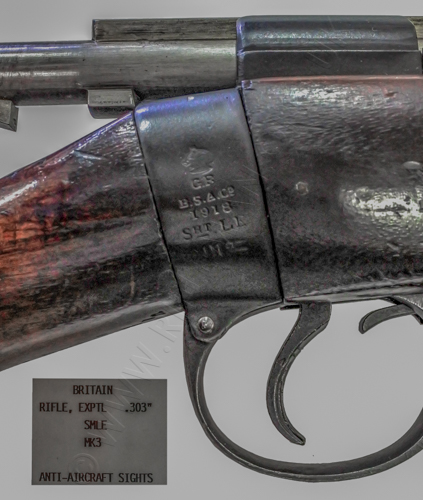
Inset: the Pattern Room tag.
A combination of a lack of robustness, problematic operation, and probably likely effectiveness,
meant that any proposed issue to the Royal Fling Corps or Royal Naval Air Service never occurred.
Nor was the rifle seen in the trenches, where it may have been of alternative use.
View this facsimile of
Provisional Notes on Firing at Aircraft with MG and other Small Arms - 1917
Another invention for sighting a No.1 Lee-Enfield rifle against attacking aircraft was trialled in 1916.
It consisted of a celluloid square slid under the rifle barrel's tangent rear-sight.
The Small Arms Committee's minute on the subject is replicated below.
The device was considered too fragile for realistic use in the field.
The 1931 Small Arms Manual carried inter-war updating of anti-aircraft techniques and equipment, and the sighting system on the illustrated experimental rifle is shown clearly with instructions for its employment.
The arrangement was already in use with the Lewis Gun, and training with both this light automatic and the service rifle is covered in the manual, as is the Spotlight Projector that could be attached to either arm for comparatively realistic training for the 'lead' necessary when firing at objects moving fast in three dimensions at various angles of approach (or departure).
At this time the Lee-Enfield No.1 Mk.III, Lee-Enfield No.1 Mk.V, and Enfield No.3 (P'14) rifles rifle had yet to be replaced
by the Lee-Enfield No.4 rifle that was in gestation in the form of the No.1 Mk.VI trials rifle.
The Lewis Gun remained in service throughout both the First and Second World Wars.
This text-searchable flip-page document that may take a few moments to load.
After making a search entry, click search magnifier twice
A further extract from the 1931 Small Arms Manuals covered Anti-aircraft training,
and included a section on the use of .22 rimfire ammunition for the task.
This is also in the form of a text-searchable flip-page document
that may take a few moments to load.
Double tap tablet or click ![]() for full page display.
for full page display.
See also: the Long Lee-Enfield adapted for early WWI Royal Flying Corps aerial use.
and the WWII Spotlight Projector Anti-aircraft training attachment for use with
the S.M.L.E. Rifle, the Lewis Machine Gun, and the Thompson sub-machine gun.
See also: other Experimental and Trials Lee-Enfield Rifles
Return to: TOP of PAGE
See this website's Raison d'être